To the source of the Ganga
I had wanted to go to Gaumukh/Tapovan ever since I heard the experiences of a few office friends who had been there. They had the most wonderful stories to tell about the place. How the Bhagirathi emerges from the mouth of the Gaumukh glacier, how they trekked over the glacier to reach Tapovan, about the Babaji who stays at Tapovan all year round, how they had khichdi at Tapovan that seemed to be cooked in kerosene oil. Most of all they were mesmerized by the beauty of the place and used the word 'heaven' a lot in their description.
We finally made up a plan for Gangotri/Gaumukh/Tapovan in June 2006. I was joined by two colleagues from office - Satish and Deepak Rath. We worked out a rough itinerary and booked a taxi. Our plan was...
Day 0 - Leave Delhi around 10pm - overnight to Rishikesh - 226 km drive on NH-58
Day 1 - Rishikesh to Gangotri(3048m) - 253 km drive via Uttarkashi
Day 2 - Gangotri to Bhojbasa(3792m) - 14km trek via Chirbasa(3350m)
Day3 - Bhojbasa to Tapovan(4463m) via Gaumukh(4000m) - trek 4 + 4 km - back to Bhojbasa
Day4 - Bhojbasa to Gangotri, drive back to Delhi
Day 0 - Leaving Delhi
We stumbled into our first road-block even before we started. I had booked a cab from the local taxi stand. The cab was supposed to pick me up at 10 pm after which we would pick up Satti and Rath from the office (Noida). At 9:30 pm, I called up the taxi stand to confirm the status. To my dismay, I was told that the driver who was supposed to come with us had fallen sick. I urged the person to arrange another cab from somewhere. After a while, he called back to tell me that an Indica is supposed to arrive from Agra around 11 pm and he has agreed to go to Gangotri. We waited anxiously for the Indica to arrive. By 12 am, we were really frustrated and no longer sure if we would be able to leave. To my great relief, the car finally arrived at 1 am. However, the driver was very reluctant to go on this route. He was concerned about the bad roads. He was also afraid that the Uttaranchal police was being very strict on cabs operating without commercial license. He was convinced that the other taxi-wala was just faking sickness. I assured him that nothing would happen and also offered him some extra trip. We picked up Satti and Rath, and started toward Rishikesh, nearly 3 hours late from our plan.
Luckily, we didn't run into much traffic and made swift progress. The driver cribbed for a while but soon settled in a holiday mood with us. Midway, we stopped for a cup of tea and had aaloo paranthas that I had got from home. On the way, we enjoyed a beautiful sunrise. Neither of us are used to waking up early so this was indeed a rare sight for us. We reached Rishikesh around 6 am and continued towards Uttarkashi.
Day 1 - Rishikesh to Gangotri
Right after Rishikesh, the hilly route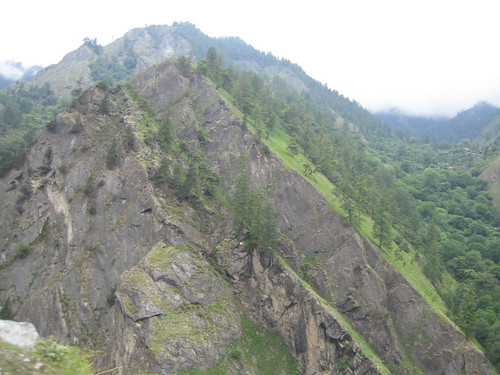 starts. The mountain surroundings provide a spectacular view. Rishikesh to Gangotri is roughly 256 km and approximately 11-12 hour drive. The route goes via Narendranagar, Chamba, Dharasu, Uttarkashi, Maneri and Hasil. Uttarkashi is 155 km from Rishikesh, on the bank of Bhagirathi. Bhagirathi emerges from the Gaumukh glacier and joins Alaknanda at Deoprayag to form the Holy Ganges. Nehru Institute of Mountaineering (NIM) is also located at Uttarkashi. We stopped at Uttarkashi for lunch. After lunch, I caught up with the night's lost sleep as we drove on from Uttarkashi. After Hasil, our driver realized that due to the climb the car was burning more diesel than he expected, and we wouldn't have enough to come back. There were no petrol pumps from now on. We tried to buy some diesel from shops but without any luck. With no alternative we decided to keep going till Gangotri. In the worst case, one of us would have to hitch a ride to get some diesel in a can. The condition of the road deteriorated rapidly as we approached Gangotri. Some sections of the road were completely broken. We managed to reach Gangotri before dark.
starts. The mountain surroundings provide a spectacular view. Rishikesh to Gangotri is roughly 256 km and approximately 11-12 hour drive. The route goes via Narendranagar, Chamba, Dharasu, Uttarkashi, Maneri and Hasil. Uttarkashi is 155 km from Rishikesh, on the bank of Bhagirathi. Bhagirathi emerges from the Gaumukh glacier and joins Alaknanda at Deoprayag to form the Holy Ganges. Nehru Institute of Mountaineering (NIM) is also located at Uttarkashi. We stopped at Uttarkashi for lunch. After lunch, I caught up with the night's lost sleep as we drove on from Uttarkashi. After Hasil, our driver realized that due to the climb the car was burning more diesel than he expected, and we wouldn't have enough to come back. There were no petrol pumps from now on. We tried to buy some diesel from shops but without any luck. With no alternative we decided to keep going till Gangotri. In the worst case, one of us would have to hitch a ride to get some diesel in a can. The condition of the road deteriorated rapidly as we approached Gangotri. Some sections of the road were completely broken. We managed to reach Gangotri before dark.
As the source of the Ganges, Gangotri is one of the holiest places in India. According to Hindu mythology, King Bhagiratha persuaded the Goddess Ganga to come down from heaven so that he could release the tormented souls of his ancestors. It is at Gangotri that Lord Shiva received the Ganga in his matted locks to break the impact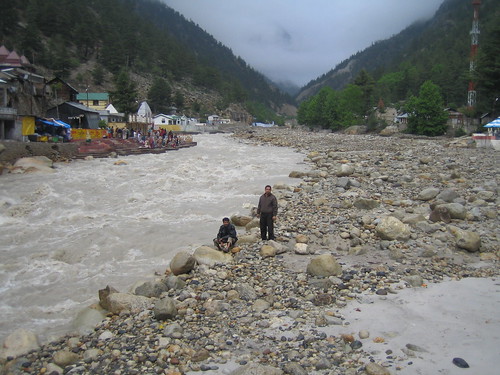 of her fall. Hundreds of years back, the entire stretch of land from Gaumukh to Gangotri was actually covered with Glaciers and Ganga did emerge from this place. Since then the glacier has receded more than 14 km.
of her fall. Hundreds of years back, the entire stretch of land from Gaumukh to Gangotri was actually covered with Glaciers and Ganga did emerge from this place. Since then the glacier has receded more than 14 km.
Gangotri is crowded with dharamshalas, hotels and lodges. We found a cheap room in a lodge (300 Rs for the night). After unloading our luggage, we walked to the river through a narrow crowded market. On the bank of the river is the holy temple of Ganga originally constructed by Gorkha Commander Amar Singh Thapa of Nepal. Deciding that it was too late for the temple, we crossed the bridge to get to the other side of the river. We remained along the river bank enjoying the surroundings till it got dark. After that we came back to the lodge. The lodge owner introduced us to a guide and insisted that a guide was must if we wanted to go till Tapovan. We settled at a rate of Rs 300 per day with food and lodging extra. Looking back, hiring a guide proved to be a total waste. There is a clear trek till Gaumukh and the further trail to Tapovan is usually marked with little piles of stone. So we ended up spending about 1200 Rs just for walking with him. After dinner we went to bed planning to start real early the next day.
Day 2 - Gangotri to Bhojbasa I woke up in the morning to find it was drizzling outside. I went to the balcony. It was a wonderful view with the small drops falling against a background of huge mountains. But I knew rain was not good for our plan. I have always believed that rains make for the most difficult trekking conditions. Fortunately it was not raining that hard right now. We had a cup of tea and got ready. For the next hour we waited for our guide to show up. The rain only got heavier and we were feeling a little anxious by now. Our guide showed up at 8:30 am. Apparently he was waiting for the rain to stop. By now we had accepted the fact that we would be trekking in rain. We bought large polythene raincoats to cover ourselves and started the trek.
I woke up in the morning to find it was drizzling outside. I went to the balcony. It was a wonderful view with the small drops falling against a background of huge mountains. But I knew rain was not good for our plan. I have always believed that rains make for the most difficult trekking conditions. Fortunately it was not raining that hard right now. We had a cup of tea and got ready. For the next hour we waited for our guide to show up. The rain only got heavier and we were feeling a little anxious by now. Our guide showed up at 8:30 am. Apparently he was waiting for the rain to stop. By now we had accepted the fact that we would be trekking in rain. We bought large polythene raincoats to cover ourselves and started the trek.
The trek starts through a preserved forest area. We paid for the forest permits at a small counter. A sign-board put up there said no polythene allowed but I don't think it acted as much deterrent. Later on we spotted a number of discarded pol ythene bags and wrappers through out the trek and at Bhojbasa there was a plastic dump. I wish more is done to spread awareness and punish the offenders. All of us must take care not to leave behind non-disposable wastes at such places.
ythene bags and wrappers through out the trek and at Bhojbasa there was a plastic dump. I wish more is done to spread awareness and punish the offenders. All of us must take care not to leave behind non-disposable wastes at such places.
The forest soon thinned into a landscape of brown and grey, with framed views of the mountains in front. The trek is fairly well maintained and hugs the river in most parts. The rain stopped after we had trekked for an hour. On the way we came across a stream falling down the side of the hill and flowing right across the trek into the Bhagirathi below. A rudimentary bridge was constructed over the stream by keeping two wooden logs side by side. We crossed plenty such bridges  till Bhojbasa and everytime it was a mini adventure. At couple of intermediate stops, there were small chai-shops inside small plastic tents.
till Bhojbasa and everytime it was a mini adventure. At couple of intermediate stops, there were small chai-shops inside small plastic tents.
8 km of trekking brings you to Chirbasa. The place derives its name from the pine (chir) trees that grows there. There is a forest bungalow and few dhabas at Chirbasa. Few chairs were laid out in a beautiful location in front of a dhaba. We sat down for a rest and ordered tea and maggi.
Above Chirbasa, the valley widens, and offers views of snow-clad peaks in the south. It is a gentle walk to Bhojbasa (3792m). We reached Bhojbasa around 2pm. Bhojbasa is named so after the silver birch trees. Growing to about 15ft, the silver birch is a very attractive tree. The bark of the tree is a fine, slightly brittle material, and tends to curl. Before paper came to India, manuscripts were written on this bark called the 'bhojpatra'. Although we didn't really see too many trees at Bhojbasa.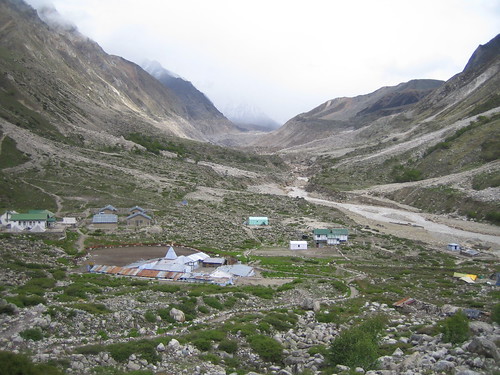 Bhojbasa is the widest point in the upper valley with a wonderful view of the Bhagirathi peaks. Almost everyone coming to Gaumukh or Tapovan, plans a stopover at Bhojbasa. There is a GMVN guesthouse and Lal Baba's Ashram for accommodation. Few tent like structures were constructed along the trek by putting thick plastic covers over stone walls and wooden frames. The front of each tent had an oven and acted as a dhaba with chairs spread out in open. The back of the tent had beddings laid out in two rows that acted as a small 20 people dormitory at Rs 80 per head.
Bhojbasa is the widest point in the upper valley with a wonderful view of the Bhagirathi peaks. Almost everyone coming to Gaumukh or Tapovan, plans a stopover at Bhojbasa. There is a GMVN guesthouse and Lal Baba's Ashram for accommodation. Few tent like structures were constructed along the trek by putting thick plastic covers over stone walls and wooden frames. The front of each tent had an oven and acted as a dhaba with chairs spread out in open. The back of the tent had beddings laid out in two rows that acted as a small 20 people dormitory at Rs 80 per head.
We occupied the chairs in front of the first tent. We had a lunch of aaloo paranthas with pickle and a cup of tea. During lunch we met an elderly couple th at had come from Haryana for the Gangotri/Gaumukh pilgrimage. Both of them were in their late fifties. We were really surprised to find out that they had planned to cover the entire Gangotri - Gaumukh trek and back to Gangotri in a single day. They had left Gangotri with sunrise and were now already on their way back from Gaumukh. Everyone at Gangotri had told them that it would be impossible to do the return trip of 36 km in a day, specially at their slow pace. I admit it did look a daunting task even for us. But they believed in themselves and were about to prove that nothing is impossible once you set your mind to it. After lunch we discussed the idea of going to Tapovan the same day. We were a little tired but felt we had enough time to do another 8 km to Tapovan. Satti and I were really tempted by the idea of spending the night there. Even though we were not carrying tents, we knew that we would be able to stay at one of the ashrams. However, our guide was convinced that it was too late. He maintained that it would be a big risk to start for Tapovan with tired legs and it would be too cold at Tapovan to spend the night. Satti and I didn't agree with him and we even thought about hiring another guide to take us. But Rath declared that he was really tired and not going anywhere. So it was decided to spend the night at Bhojbasa. We were initially reluctant at the idea of staying in a tent packed with 20 people. But the guest-house was full and the available rooms in the Ashram were really small and unclean.
at had come from Haryana for the Gangotri/Gaumukh pilgrimage. Both of them were in their late fifties. We were really surprised to find out that they had planned to cover the entire Gangotri - Gaumukh trek and back to Gangotri in a single day. They had left Gangotri with sunrise and were now already on their way back from Gaumukh. Everyone at Gangotri had told them that it would be impossible to do the return trip of 36 km in a day, specially at their slow pace. I admit it did look a daunting task even for us. But they believed in themselves and were about to prove that nothing is impossible once you set your mind to it. After lunch we discussed the idea of going to Tapovan the same day. We were a little tired but felt we had enough time to do another 8 km to Tapovan. Satti and I were really tempted by the idea of spending the night there. Even though we were not carrying tents, we knew that we would be able to stay at one of the ashrams. However, our guide was convinced that it was too late. He maintained that it would be a big risk to start for Tapovan with tired legs and it would be too cold at Tapovan to spend the night. Satti and I didn't agree with him and we even thought about hiring another guide to take us. But Rath declared that he was really tired and not going anywhere. So it was decided to spend the night at Bhojbasa. We were initially reluctant at the idea of staying in a tent packed with 20 people. But the guest-house was full and the available rooms in the Ashram were really small and unclean.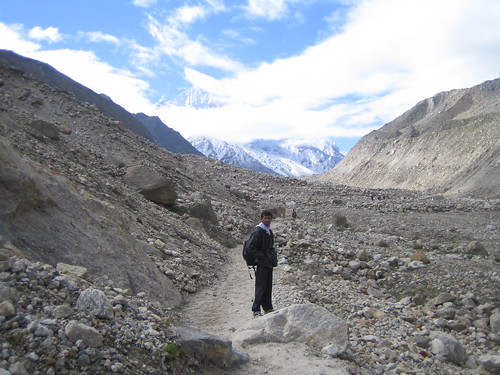
Rath went to sleep but Satti and I were feeling fresh after the lunch and decided to explore the surroundings. We figured that Gaumukh is probably too far at 4km. Instead we decided to go to the base of the snow peaks in front of us. What we didn't realize at the moment was that what looked like only a couple of kilometers was infact a lot further away. As it turned out we ended up reaching Gaumukh without getting any nearer to the peaks. Both of us left Bhojbasa around 3pm.
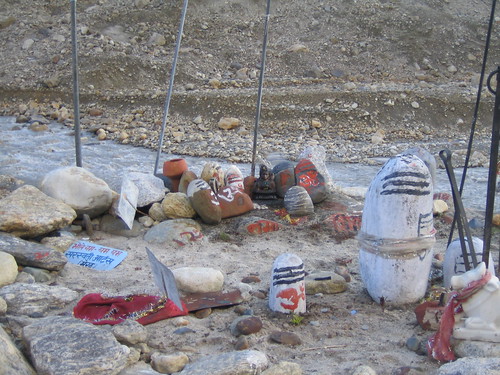 It was a nice gentle trek and we were walking at a leisurely pace soaking in the wonderful scenery. After a couple of kms we realized our folly that the snow peaks were actually the Bhagirathi peaks and very far away. We changed plans to go till Gaumukh. Somewhere before Gaumukh we had our first glimpse of the snow covered Shivaling peak.A kilometer before Gaumukh the trail ends abruptly and is replaced by a rocky terrain. One has to pick his way through rocks and boulders. Just before Gaumukh there is a small shrine of Lord Shiva.
It was a nice gentle trek and we were walking at a leisurely pace soaking in the wonderful scenery. After a couple of kms we realized our folly that the snow peaks were actually the Bhagirathi peaks and very far away. We changed plans to go till Gaumukh. Somewhere before Gaumukh we had our first glimpse of the snow covered Shivaling peak.A kilometer before Gaumukh the trail ends abruptly and is replaced by a rocky terrain. One has to pick his way through rocks and boulders. Just before Gaumukh there is a small shrine of Lord Shiva.
As we approached the origin of the river, we were a little confused. It appeared that the Bhagirathi was flowing out of the mouth of a small mountain. Where was the glacier, the river of ice, we wondered. We drew closer to the U shaped mouth of the river, making our way forward along the river bank. We noticed that most pilgrims had stopped near the shrine but we wanted to get as close as possible to the mouth. We were warned to be careful of the falling stones.
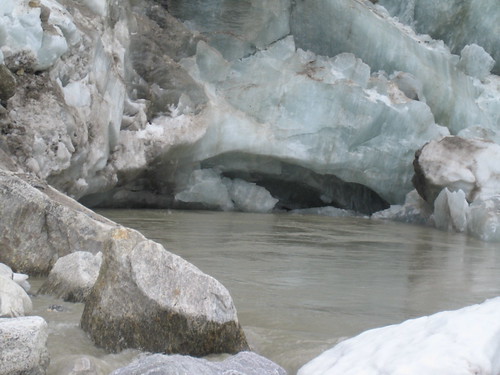 We continued inching closer, climbing over small rocks and boulders along the edge of the slope. Slowly we began detecting flecks of white under the mud and rocks. It was then the reality hit us like a lighting. The small mountain that surrounded us from three sides was solid ice covered with mud and rubble. In front of us, Bhagirithi was flowing out of a solid cross-section of 200 feet of ice. Huge chunks of compacted ice were falling off the face of the glacier into the river. At the very top of the glacier, like a crust of crunchy chocolate on a vanilla bar, was a 30 to 50 foot layer of mud and rock, the debris dragged down the mountains by the flow of glacial ice. We were amazed at the enormity of the scene. It was unlike anything either of us had seen before.
We continued inching closer, climbing over small rocks and boulders along the edge of the slope. Slowly we began detecting flecks of white under the mud and rocks. It was then the reality hit us like a lighting. The small mountain that surrounded us from three sides was solid ice covered with mud and rubble. In front of us, Bhagirithi was flowing out of a solid cross-section of 200 feet of ice. Huge chunks of compacted ice were falling off the face of the glacier into the river. At the very top of the glacier, like a crust of crunchy chocolate on a vanilla bar, was a 30 to 50 foot layer of mud and rock, the debris dragged down the mountains by the flow of glacial ice. We were amazed at the enormity of the scene. It was unlike anything either of us had seen before.
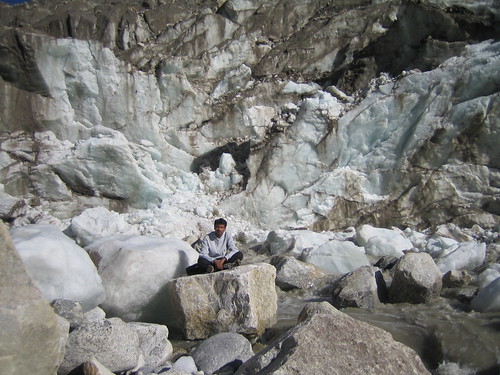 Totally mesmerized by the surroundings, we walked till the very edge of the glacial wall. We photographed each other against the background of ice. Stepping carefully over a few large stones positioned across the path of the river, got us a third of the way towards the opposite bank. We sat down on the last stone and put our legs in the freezing water. There we were alone, surrounded by the glacier, at the origin of the Ganges, with the river flowing beneath us. Both of us were two awed to speak much. We just sat there for a long time.
Totally mesmerized by the surroundings, we walked till the very edge of the glacial wall. We photographed each other against the background of ice. Stepping carefully over a few large stones positioned across the path of the river, got us a third of the way towards the opposite bank. We sat down on the last stone and put our legs in the freezing water. There we were alone, surrounded by the glacier, at the origin of the Ganges, with the river flowing beneath us. Both of us were two awed to speak much. We just sat there for a long time.
I wouldn't say I felt very peaceful there. On the contrary, I was a bit nervous, aware of a strong force around us. Nature was at its dynamic best here. Ganges was flowing down with a fury around us. Chunks of ice were falling off the glacier into the river and being carried downstream by the flow. Sm all stones and pebbles were rolling down the slope near us. I knew that the glacier, that once existed till Gangotri, is receding rapidly each year.
all stones and pebbles were rolling down the slope near us. I knew that the glacier, that once existed till Gangotri, is receding rapidly each year.
The realization of this powerful and dynamic force, brought contradictory emotions inside me. On one hand, I realized that it was probably not very safe to be sitting so close to the glacier and we should go back. On the other hand, I wanted to surrender myself to the intoxicating force and be there for all eternity. Lost in the confusing emotions, I was brought to my senses by a most remarkable incident that I would remember all my life. Suddenly there was a loud thunderous sound, and even before realizing what had happened, the sixth sense was alerting me to some danger. I looked up to see a huge chunk of ice, the size of a big car or a bus, cracking from the face of the glacier and falling down into the opposite end of the river. The chunk displaced a huge wave in the river that traveled straight towards us, threatening to sweep us away. I clearly remember feeling that it was all going to end here. Within a moment adrenalin kicked in and we were on our feet in a flash. Satti shouted 'Bhaag' (run) but before we could flee the wave broke across our bodies drenching us.
Looking back at the incident, I realize that in the moment of panic, our shocked mind had greatly exaggerated the danger that the wave presented to us. It was a big wave but it died before it reached us. In the end it was like getting soaked by a big wave at Marine Drive. We were never in any real danger, but the emotions that ran through us were as real as it gets. We were visibly shaken and drenched. The whole incident would not have lasted more than a couple of seconds. But things seemed to happen in slow motion and even after a year I still remember everything clearly. Thinking about it still gets adrenalin flowing to my veins and it will remain one of the most memorable moments of my life. Afterwards, we shared a loud nervous laughter. We decided to get the hell out of there before another of those big chunks fall over us this time. I still tease Satti about how he had panicked and shouted 'Bhaag' at the top of his voice. But he realizes that I had panicked as much as he had.
 Back at the Shrine, we refocused our thoughts and headed towards Bhojbasa. Instead of following the trek that curves away, we decided to walk along the river. A little further we came across a tent belonging to a couple of researchers. They were staying at Gaumukh to study the rate at which the glacier was receding and the factors responsible. The glacier which forms a mass of ice about 18 miles long, is retreating at a rate of more than 100 feet a year. While the glacier has been retreating since measurements began in 1842, the rate of retreat, which was around 62 feet per year between 1935 and 1971, has almost doubled. Global warming is mainly responsible for this drastic change. At such a rapid retreat, a gradual increase in droughts, flash floods, and landslides are really something to be worried about.
Back at the Shrine, we refocused our thoughts and headed towards Bhojbasa. Instead of following the trek that curves away, we decided to walk along the river. A little further we came across a tent belonging to a couple of researchers. They were staying at Gaumukh to study the rate at which the glacier was receding and the factors responsible. The glacier which forms a mass of ice about 18 miles long, is retreating at a rate of more than 100 feet a year. While the glacier has been retreating since measurements began in 1842, the rate of retreat, which was around 62 feet per year between 1935 and 1971, has almost doubled. Global warming is mainly responsible for this drastic change. At such a rapid retreat, a gradual increase in droughts, flash floods, and landslides are really something to be worried about.
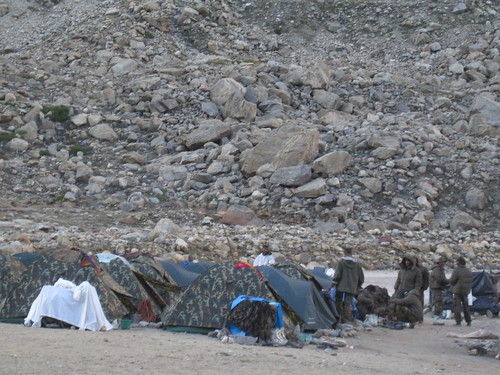
We were feeling a little lost, when we came across an army camp. We walked into the camp and had a chat with some of the army men. They were posted at Gaumukh to learn mountaineering skills on the glacier. The next day, we actually saw them in action on the vertical ice cliffs with their ice axes and crampons. After a quick chat, we asked for the directions and rejoined the trek. 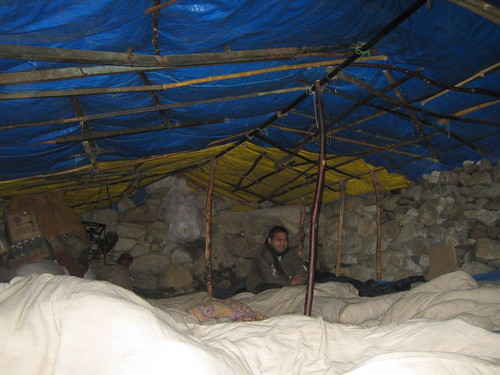
The light was fading fast and we increased our pace to make sure we made it back to Bhojbasa before dark. We stopped at the ashram to deliver a message that someone at Gaumukh had sent for his fellow travelers. We reached our tent to find Rath safely tucked under the blankets. Soon we got rid of our shoes and joined him. The dinner was again aaloo paranthas.
A lot of other people came back from Gaumukh and started filling the tent. I observed that almost 80% of the people around me were Bengalis. I have continued to notice a similar trend in almost all of my treks. Bengalis have an insatiable desire for travel that makes them pack their bags and leave for an adventure at the first opportunity.Around 9 pm, I learned that a group in the tent was still waiting for a couple of people to come back from Gaumukh. I was surprised and wondered how they would be able to make their way back in the night. Going outside the tent, I got my answer. An almost full moon was filling the entire valley with a milky white light. Those who haven't been to the hills on a full moon night, would probably never realize how bright the moonlight can be. I felt we could easily trek till Tapovan in this light. This made me regret our decision, to not go to Tapovan, even more.
I dragged Satti out of the tent for a walk. It was a wonderful experience to walk in the soft moonlight. Since that night, I have always wanted to do a longer trek under full moon. After following the trail to Gaumukh for a while, we descended down the valley towards the river. We reached the bank and sat down on a rock. It was wonderfully peaceful this time round. I have known Satti for a long time. He is an unusually quiet guy and its difficult to drag him into a conversation. He doesn't hold strong opinions about most things except cricket and football. I am not a very talkative person myself. So we were mostly quite sitting there along the river under full moon. But sometimes quite moments goes a long way in cementing bonds of friendship and I felt this was one such moment.
By the time we got back to the tent, everyone was gearing up for sleep. All of us tucked ourselves under blankets. It had been a long day. We had walked about 25 km, that was the most I had done in a day till then. I was hoping for a refreshing sleep but had no such luck. I heard someone snoring loudly. The disease seemed contagious , for soon I could hear atleast 3 more snoring sounds. Two of them were coming from Satti and Rath who were asleep on my either side, giving me a complete surround sound experience. I tried to go to sleep but without any success. I was so frustrated I wanted to kill both of them. I tried shaking them but that only turned off the music for a short while. I wondered how the others were able to sleep. The whole night passed in complete agony for me. I was able to get only brief moments of sleep throughout the night. Not a good ending to an otherwise wonderful day...
Day 3 - Bhojbasa to Tapovan via Gaumukh - back to Bhojbasa
We woke up to a beautiful sunny morning. After a cup of tea, it was time for the morning routines. I asked the tent owner about the toilets. He handed me a bottle and pointed towards the rocks. It took some time for the cruel reality to sink in, before I started walking gingerly towards the pointed direction. Like so many other firsts on the tre k, this was also a new experience for me. I made sure I got as far as possible and sat behind a rock to do the needful.
k, this was also a new experience for me. I made sure I got as far as possible and sat behind a rock to do the needful.
After breakfast we started for the day's journey. The walk till Gaumukh was already familiar to us. Instead of going to the mouth of the glacier this time, we climbed over the northern side. The holy trail ends at Gaumukh and the path becomes dodgy after that. We climbed to the top of the glacier snaking through loose debris and hopping over a few boulders. The route here changes frequently due to the movement of the glacier. We were a bit disoriented at first and relied on our guide for directions. However, pretty soon we realized that piles of stones were kept on the higher rocks to mark the way.
After reaching level, we turned south to cross the glacier. Huge crevasses in the path reminded us that we were actually on a huge glacier. Few accidents have been known to happen where a person got trapped inside after falling through one of these gaps. We could hear water trickling underneath.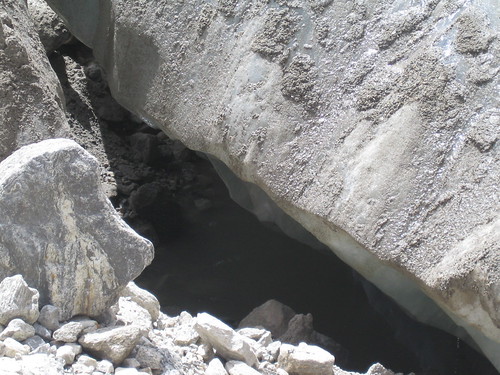
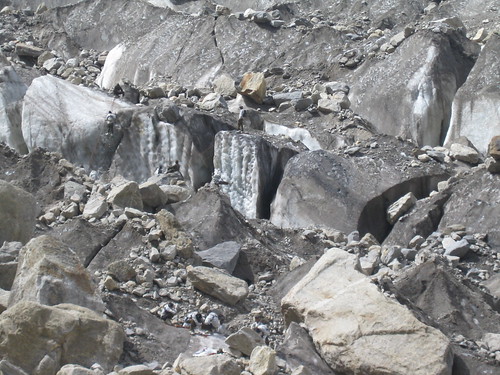 Going higher, we spotted a team from the Indian army, practicing mountaineering techniques on the glacier. Few members were climbing a vertical wall of ice. They were laboriously making their way up with the help of ice-axes and crampons, while their team members held the rope for them. Similar exercise was going on another 75 degree ice slope. We were told that a team would later be attempting to summit one of the Bhagirathi peaks.
Going higher, we spotted a team from the Indian army, practicing mountaineering techniques on the glacier. Few members were climbing a vertical wall of ice. They were laboriously making their way up with the help of ice-axes and crampons, while their team members held the rope for them. Similar exercise was going on another 75 degree ice slope. We were told that a team would later be attempting to summit one of the Bhagirathi peaks.
Our walk had become pretty laborious itself. We were beginning to feel the effect of steep climb and high altitude. The bad path was not making things any easier. We were panting for breath and stopping frequently for a rest.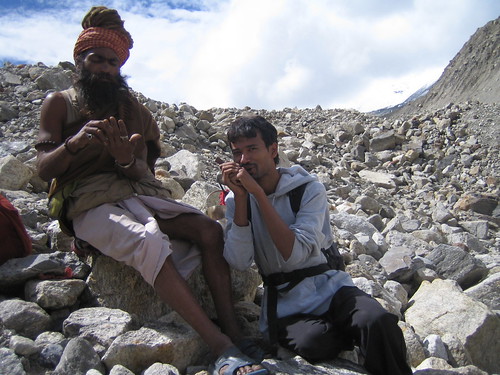 We ran into a Sadhu on the way. He was dressed in a vest, light jacket and lungi. He had a big beard and his long braided hair was wrapped around his head with a turban. He had sat down for a rest. As we approached him, he asked us if we would like to have some Charas. We were intrigued by this offer but declined politely. Then he proceeded to take out a 'chilam' from his pockets and lighted it up. He exclaimed that he was badly in need of some energy before the final climb.
We ran into a Sadhu on the way. He was dressed in a vest, light jacket and lungi. He had a big beard and his long braided hair was wrapped around his head with a turban. He had sat down for a rest. As we approached him, he asked us if we would like to have some Charas. We were intrigued by this offer but declined politely. Then he proceeded to take out a 'chilam' from his pockets and lighted it up. He exclaimed that he was badly in need of some energy before the final climb.
Sadhu Baba had set off on the 'char-dham' yaatra from Rishikesh on foot. He had already been to Badrinath and Kedarnath. A devotee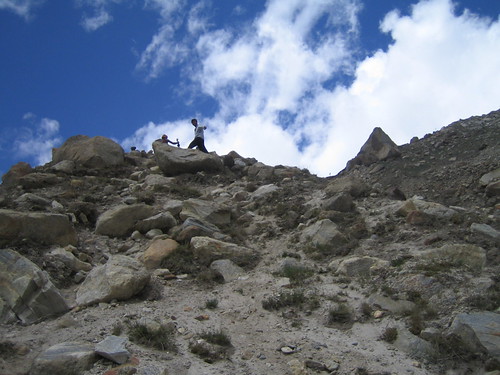 of Lord Shiva, Babaji wandered in the mountains in his rubber slippers and light clothing. He was without any provisions, money or spare clothing. He used to eat whatever other devotees offered him. Most of the time he was high on charas. Although I didn't approve of his chosen lifestyle, I took an immediate liking to the Baba. He was lost in a world of his own. Unlike usual Sadhus, he never preached or tried to coerce any money from us.
of Lord Shiva, Babaji wandered in the mountains in his rubber slippers and light clothing. He was without any provisions, money or spare clothing. He used to eat whatever other devotees offered him. Most of the time he was high on charas. Although I didn't approve of his chosen lifestyle, I took an immediate liking to the Baba. He was lost in a world of his own. Unlike usual Sadhus, he never preached or tried to coerce any money from us.
Babaji joined us for the rest of the journey. Soon we were standing beneath a nearly vertical wall of stones and debris around 1000 feet high. We looked for a way around it. When our guide told us that the way is straight up, we thought he was joking.The climb was both exhausting and dangerous. We had to stop for breath after every 10 steps. The debris didn't allow for a good footing. One slip and there was nothing to break the fall for a long way. Few slippery corners found us on all fours clinging to the slope.
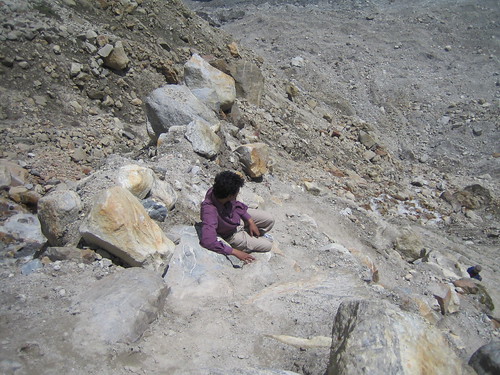
As we climbed, we got a wonderful view of the snow covered Bhagirathi. Bhagirathi are the group of three high peaks namely Bhagirathi - I,II,III with the height of 6856, 6512, 6454 meters.

 A little more effort took us to the top that opened into a large meadow at the base of Shivaling. This was Tapovan named so because several Sadhus choose this spot for extended meditations (tap). To be honest, I was a bit disappointed. The place was beautiful but I had expected something much more remarkable after my friends' description. There was no carpet of grass and no blooming flowers. The place was a vast field of stones and dried grass. Perhaps it wasn't the best time to be there or perhaps going there with a preconceived image was an even bigger mistake. However, the journey to Tapovan was most memorable and the backdrop of Bhagirathi and Shivaling peaks made for a splendid view. Totally exhausted by the climb we lied down on the grass for a long time.
A little more effort took us to the top that opened into a large meadow at the base of Shivaling. This was Tapovan named so because several Sadhus choose this spot for extended meditations (tap). To be honest, I was a bit disappointed. The place was beautiful but I had expected something much more remarkable after my friends' description. There was no carpet of grass and no blooming flowers. The place was a vast field of stones and dried grass. Perhaps it wasn't the best time to be there or perhaps going there with a preconceived image was an even bigger mistake. However, the journey to Tapovan was most memorable and the backdrop of Bhagirathi and Shivaling peaks made for a splendid view. Totally exhausted by the climb we lied down on the grass for a long time.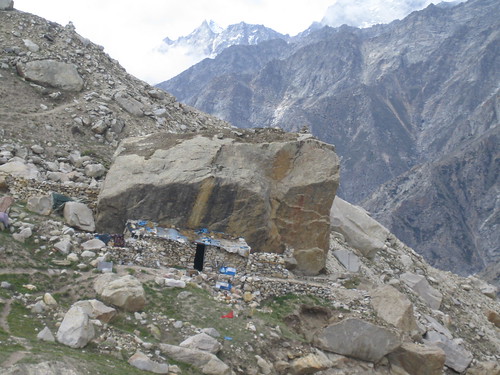
There are a couple of ashrams at Tapovan.Both offer places to stay, food to eat, tea. My office friends had stayed at the Shimla Baba's ashram where they had kerosene khichdi. Our guide led us to the ashram of Bengali Mata. The ashram was built around a small cave under a huge boulder. Bengali Mata had been staying at Tapovan throughout the year for a long time. She was dressed in normal clothes.
All of us sat down on mats laid out in front of the ashram. We were immediately offered some tea. Our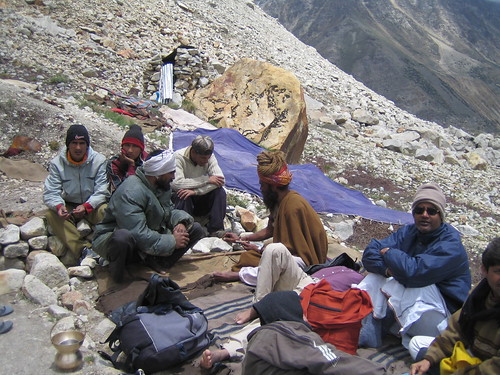 own Sadhu Baba joined us a little later with another companion. The person belonged to Calcutta and worked for Ramakrishna Trust. A pronounced bachelor he was extremely fond of traveling. There was another interesting fellow from Delhi. A businessman who had been coming to Tapovan for a full month for the last 8 years. I told him if I had that much time I would go and see all the other places. There is certainly no shortage of places in Himalayas. But he insisted he felt a peace there unlike he had ever felt anywhere else.
own Sadhu Baba joined us a little later with another companion. The person belonged to Calcutta and worked for Ramakrishna Trust. A pronounced bachelor he was extremely fond of traveling. There was another interesting fellow from Delhi. A businessman who had been coming to Tapovan for a full month for the last 8 years. I told him if I had that much time I would go and see all the other places. There is certainly no shortage of places in Himalayas. But he insisted he felt a peace there unlike he had ever felt anywhere else.
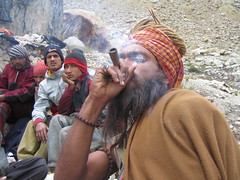 Sadhu Baba lit another 'chilam' and started getting high. He shared the chilam with a group of porters that had brought provisions for Bengali Mata. The gentleman from Delhi started talking about spirituality and stuff. He had a huge problem with the Sadhu Baba and his way of living. Rath also was making fun of Baba. He commented that Sadhu Baba must have seen Lord Shiva a lot of times. Sadhu Baba didn't take the slightest offense. Infact I doubt if he ever paid any real attention to the conversation. He lived in a different world of his own.
Sadhu Baba lit another 'chilam' and started getting high. He shared the chilam with a group of porters that had brought provisions for Bengali Mata. The gentleman from Delhi started talking about spirituality and stuff. He had a huge problem with the Sadhu Baba and his way of living. Rath also was making fun of Baba. He commented that Sadhu Baba must have seen Lord Shiva a lot of times. Sadhu Baba didn't take the slightest offense. Infact I doubt if he ever paid any real attention to the conversation. He lived in a different world of his own.
Bengali Mata invited us into the cave for the lunch. It was a neat little cave. She actually had gas stove for cooking. The food was unexpectedly delicious considering the circumstances. I have read about the bad experiences some other people have had at the ashrams at Tapovan. They complained that the Baba's are just running unlicensed hotels in the name of religion. They are greedy and overcharge for food. I must say that I never got that feeling. Although I never thought about Bengali Mata as a saint, she certainly appeared as a kind and generous person. She was affectionate in serving us food and tea. She never demanded any money from us. While leaving, our guide told us to give 100 Rs. I assumed he was talking 100 Rs per person, but it was just 100 Rs for the four of us. I don't think that was excessive at all for tea and lunch for 4 people at that height.
By the time we started back, the sun had gone behind clouds, and chilly air was starting to blow. I felt a light headache, no doubt the combined effect of altitude, cold air and sleepless night. Unfortunately, I didn't have any woolen cap with m e. The descent was even trickier than the ascent. We were struggling for footholds due to all the debris and small stones on the path. One look down the slope reminded us that any lack in concentration could prove costly. Carefully we got down till Gaumukh. We spent some time at the glacier, though we didn't go as close as the last time. My headache was killing me by now. We started back for Bhojbasa. Those 4 kms proved to be the longest journey of our trek so far. My head ached with each step. It appeared to me as if Bhojbasa had receded till Gangotri. I remembered how we had just strolled to Gaumukh and back, the previous day. But now it took all my strength and will power to go on. The sight of our tents restored some energy and I raced to the destination. Once inside, i swallowed a Dispirin and went to sleep. When I woke up a couple of hours later, my headache was gone but I didn't feel too energetic. So I had my dinner and went right back to sleep...
e. The descent was even trickier than the ascent. We were struggling for footholds due to all the debris and small stones on the path. One look down the slope reminded us that any lack in concentration could prove costly. Carefully we got down till Gaumukh. We spent some time at the glacier, though we didn't go as close as the last time. My headache was killing me by now. We started back for Bhojbasa. Those 4 kms proved to be the longest journey of our trek so far. My head ached with each step. It appeared to me as if Bhojbasa had receded till Gangotri. I remembered how we had just strolled to Gaumukh and back, the previous day. But now it took all my strength and will power to go on. The sight of our tents restored some energy and I raced to the destination. Once inside, i swallowed a Dispirin and went to sleep. When I woke up a couple of hours later, my headache was gone but I didn't feel too energetic. So I had my dinner and went right back to sleep...
Day 4 - Bhojbasa to Gangotri - back to Delhi
Next day we left for Bhojbasa early morning. It took us only a couple of hours to get down to Gangotri. At Gangotri we were amazed to see so many people and vehicles. Things had seemed so normal when we had left but now it was crazy. We struggled to find our car. Our driver told us that it was Ganga Dusshera that day, and was considered very auspicious for a holy dip. Therefore so many devotees had flocked the place and more were coming in. We told him that we are going to the temple and would be back quickly. The small market before the temple was jammed with people. We made our way through the sea of bodies towards the temple, only to find an impossibly long queue there. It seemed unlikely that we would be able to get out before a couple of hours so we dropped the plan. We bought small cans from the market and went to the banks of the Ganga. Some people were bathing in the freezing cold water but we weren't in a brave mood. So we just washed our face and limbs, and filled the cans with the Holy water. Around 11 am we left for Delhi. But the huge inflow of vehicles on the narrow road created a massive jam. It took more than an hour for the jam to clear. Once we were on our way, we only took a couple of stops for lunch and dinner for the whole journey. We were back in Delhi by 4 am, just in time for a brief nap before another day at Office.

Trek pics
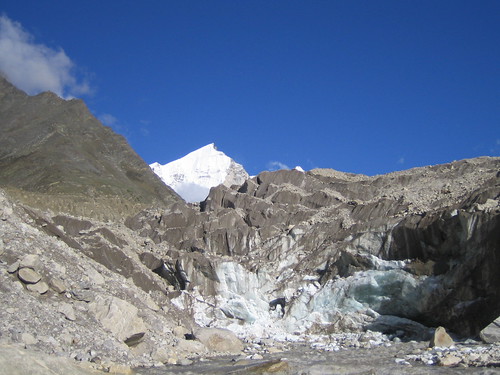
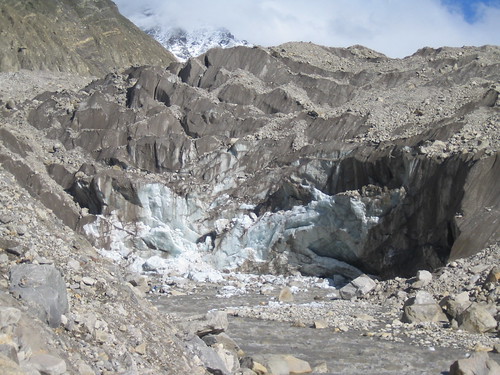
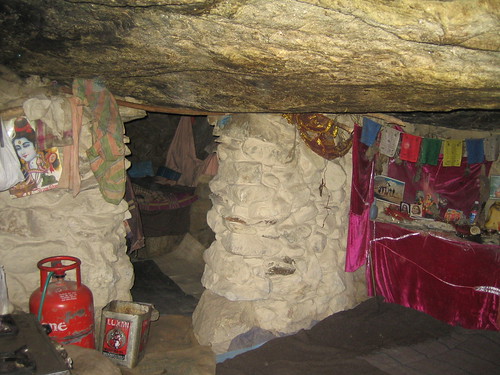

5 comments:
Nice post pal..inclined to add it to my list of places to go..lemme know when ur emarking on another one.
Dobs
Very informative piece of writing. I also liked your candid reflections! It's quite relieving that the thrills of getting in too close to Goumukh did not surpass the limiting value.
I feel your trek was in late May and as such, Tapovan meadow gets greener with abundance of blooming flowers during monsoon. However, I find the landscape ever fascinating--green or rough--with Jogin, Bhagirati sisters and Sivling all encompassing.
Had you been staying overnight, it would have been a splendid experience! Incidentally, it's one of my favoured spots, and had been to there again just this May!
Thanks for some great snaps, friend! Best wishes,
Dude...
Thats a wonderful post, its a fantastic narration of all that was going on in your mind, along the track, with many people around.
I so wish to be there as soon as possible. I have never seen any such place from proximity.
Must have been an out of the world experience.
Hats off....
Hi..
I liked your blogs..
came across it just by searching for gomukh and tapovan..
thanks for sharing it..
regards,
avani.
i m feelig like i hv also been t tapovan and gangotri
a well written journey
Post a Comment